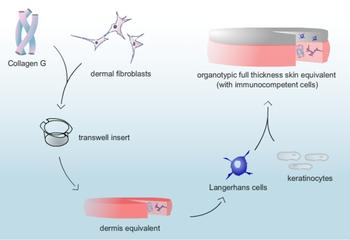Integration of Langerhans Cells into reconstructed human skin
A defective skin barrier in atopic dermatitis facilitates antigen uptake by immunocompetent cells of the skin. These immune cells include the so-called dendritic cells or Langerhans cells, which are of central importance for sensitization to xenobiotics but also for immunological skin diseases.
Currently, the sensitizing potential of substances is evaluated using animal tests such as the local lymph node assay (LLNA: OECD TG429), guinea pig-based tests (Guinea Pig maximization test, Buehler test: OECD TG406) and mouse ear swelling tests (MEST). The aim of the project is to replace these test methods in the future. Therefore, skin models with integrated antigen presenting cells will be developed which will later be used in basic and pre-clinical research.
The research group focuses on the characterization of inflammatory processes in the skin. The stable integration of immune cells into reconstructed skin, however, poses a particular challenge. Advanced test protocols for the evaluation of skin sensitization currently rely on a two-step process which separates skin penetration and immune cell activation. Several approaches using 3D skin models have been developed and the applicability to study molecular mechanisms of immunological responses has been demonstrated. The development of reconstructed skin with immunocompetent cells is in an advanced stage and the work was awarded the Animal Welfare Research Award for Berlin in 2013. The skin models are further developed and optimized in this project. The work will be done in close cooperation with the projects Kleuser and Schäfer-Korting. In particular, the skin models with integrated immune cells will be incorporated later into skin disease models. Additionally, the knowledge gained will be transferred to the “organ-on-a-chip” technology and the testing of nanomaterials in collaboration with the projects Lauster and Luch.


